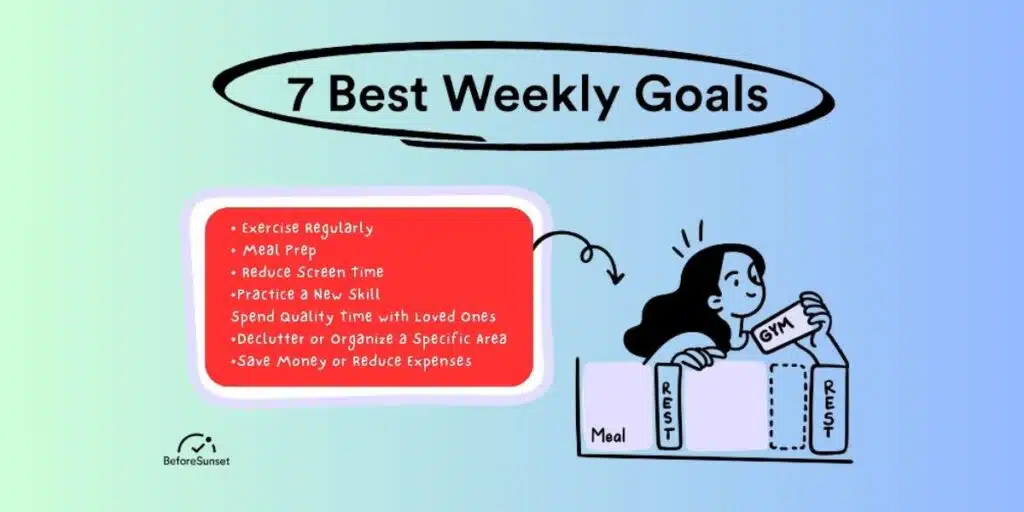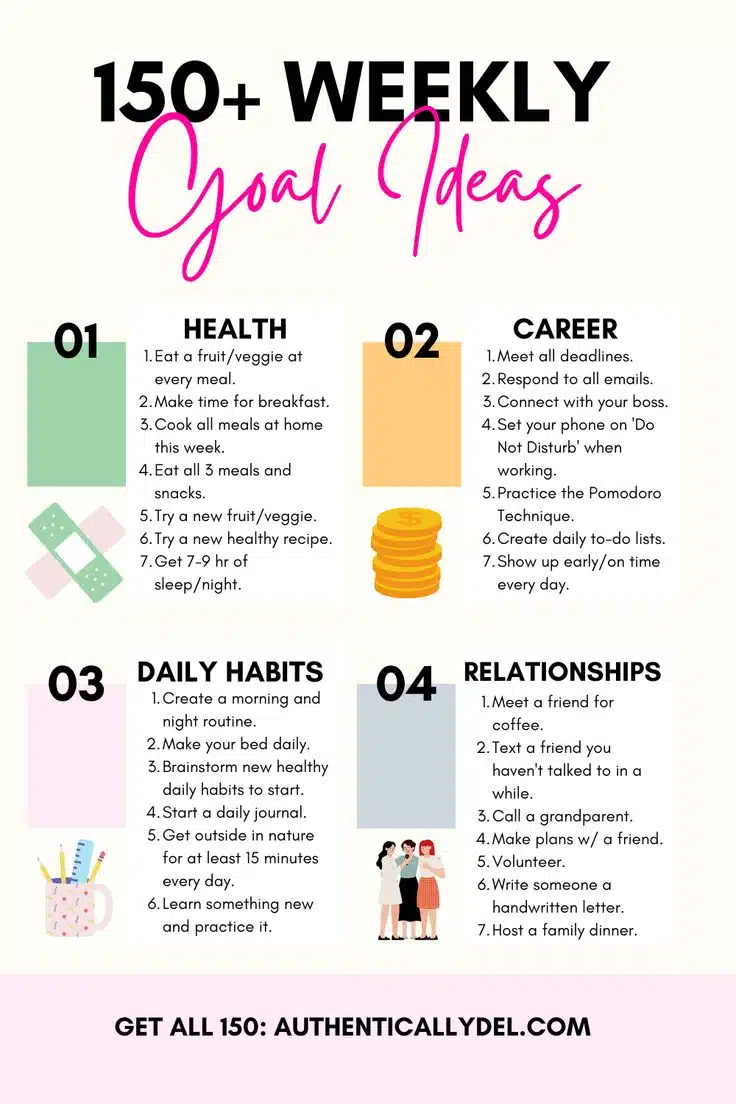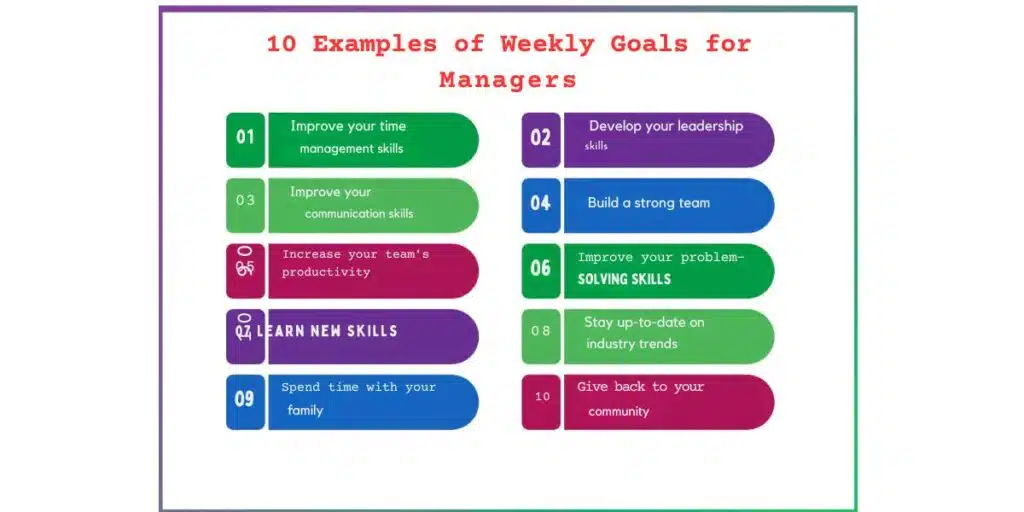Weekly goals help you stay focused and productive. They provide direction and ensure progress toward your larger objectives.
Setting weekly goals is a powerful strategy for achieving success. By breaking down larger tasks into manageable actions, you can maintain momentum and avoid feeling overwhelmed. These short-term goals serve as stepping stones that guide you toward your long-term aspirations.
They also provide a sense of accomplishment as you tick off each completed task. This consistent progress boosts motivation and confidence. It’s essential to review and adjust your goals regularly to stay aligned with your priorities. Start your week by setting clear, achievable goals, and witness the difference in your productivity and satisfaction. Prioritize effectively and make every week count.

Importance Of Weekly Goals
Setting weekly goals is crucial. It helps you stay focused and organized. Weekly goals break larger tasks into manageable pieces. This makes achieving long-term objectives easier.
Boosting Productivity
Weekly goals can significantly boost productivity. By focusing on smaller tasks, you can achieve more. This approach prevents feeling overwhelmed. It also provides a sense of accomplishment.
| Day | Task |
|---|---|
| Monday | Plan the week |
| Tuesday | Work on project A |
| Wednesday | Complete project A |
| Thursday | Start project B |
| Friday | Review and adjust |
Enhancing Focus
Weekly goals help in enhancing focus. By knowing what needs to be done, you can avoid distractions. It becomes easier to concentrate on tasks. This leads to better quality work.
- Identify key tasks for the week.
- Allocate specific time slots for each task.
- Monitor progress daily.
- Set clear and achievable goals.
- Break them into daily tasks.
- Review your progress every week.
Setting Clear Objectives
Setting clear objectives for your weekly goals is vital. It helps you stay focused and track your progress. Clear objectives provide a roadmap for your tasks.
Defining Priorities
Start by identifying what matters most. List your tasks in order of importance. Use a table to organize your priorities:
| Priority | Task |
|---|---|
| 1 | Complete project report |
| 2 | Prepare for Monday meeting |
| 3 | Reply to client emails |
By defining priorities, you know which tasks to tackle first. This ensures you spend time on what truly matters.
Measurable Targets
Make your objectives measurable. Use numbers or specific criteria to track progress. Examples of measurable targets include:
- Write 500 words daily
- Exercise for 30 minutes, 3 times a week
- Read 2 chapters of a book daily
Measurable targets help you see progress clearly. This keeps you motivated and focused on achieving your goals.
Creating A Strategic Plan
Creating a strategic plan helps you achieve your weekly goals. It involves identifying key tasks and allocating time effectively. This process ensures you stay focused and productive.
Identifying Key Tasks
To start, list all tasks for the week. Identify the most important ones. These tasks should align with your long-term goals.
Break down larger tasks into smaller steps. This makes them more manageable. You can use a table to organize your tasks:
| Task | Priority |
|---|---|
| Complete project report | High |
| Team meeting | Medium |
| Review emails | Low |
Allocating Time Effectively
Next, allocate time for each task. Use a planner or calendar. Block specific times for high-priority tasks first.
Consider the time of day you work best. Schedule difficult tasks during these times. This ensures you are most efficient.
Here’s a sample daily schedule:
8:00 AM - 9:00 AM: Complete project report
10:00 AM - 11:00 AM: Team meeting
2:00 PM - 3:00 PM: Review emails
Remember to take breaks. Short breaks improve focus and productivity. Use tools like timers to keep track of your schedule.
Creating a strategic plan makes weekly goals achievable. Start planning today and see the difference.
Tools For Planning
Setting weekly goals can drive productivity and focus. But how do you plan these goals effectively? Using the right tools is crucial. Here are some methods to help you with your weekly planning.
Digital Solutions
Digital tools offer convenience and accessibility. They can be accessed from anywhere. Here are some popular digital solutions:
- Google Calendar: Schedule tasks and set reminders. Sync across all devices.
- Trello: Organize tasks using boards and cards. Great for visual planners.
- Evernote: Take notes, set goals, and track progress. Ideal for detailed planning.
These tools help you stay organized. You can also share your plans with others easily.
Traditional Methods
Some people prefer traditional methods. They find them tangible and straightforward. Here are some options:
- Paper Planners: Write down your goals and daily tasks. Many designs available.
- Bullet Journals: Customizable and creative. Track goals in a fun way.
- Wall Calendars: See your week at a glance. Great for visual reminders.
These methods can be more personal. They also reduce screen time.
| Tool | Type | Benefits |
|---|---|---|
| Google Calendar | Digital | Syncs across devices, easy to share |
| Trello | Digital | Visual organization, team collaboration |
| Evernote | Digital | Detailed planning, note-taking |
| Paper Planners | Traditional | Tangible, many designs |
| Bullet Journals | Traditional | Customizable, creative |
| Wall Calendars | Traditional | Visual reminders, week at a glance |
Choosing the right tool can make weekly planning more effective. Whether you prefer digital or traditional methods, the key is consistency.
Tracking Progress
Tracking progress is crucial for achieving weekly goals. Consistent monitoring ensures you stay on track. It helps you identify areas needing improvement. This section will discuss effective methods for tracking progress.
Daily Check-ins
Daily check-ins are essential for staying focused. Spend a few minutes each day reviewing your progress. Use a journal or digital tool for this task. Note what you accomplished and what needs more attention.
- Write down tasks completed.
- Identify any obstacles faced.
- Adjust your plan for the next day.
Daily check-ins help you stay accountable. They keep you aware of your progress. This habit ensures small issues don’t become big problems.
Weekly Reviews
Weekly reviews provide a broader perspective. Allocate time at the end of each week for a review. This practice allows you to evaluate your overall progress.
| Review Elements | Questions to Ask |
|---|---|
| Achievements | What goals did I meet? |
| Challenges | What obstacles did I encounter? |
| Adjustments | What changes should I make? |
Weekly reviews highlight your strengths and weaknesses. They help you plan better for the coming week. This practice ensures continuous improvement.
Incorporating these practices into your routine boosts productivity. Tracking progress leads to achieving your weekly goals.

Adjusting Goals
Setting weekly goals keeps you focused and productive. Sometimes, you need to adjust them. Life isn’t always predictable. Adjusting goals helps you stay on track and motivated. This section covers how to handle setbacks and realign objectives.
Handling Setbacks
Setbacks are part of life. They test your determination and adaptability. Handling setbacks well requires a positive mindset and a flexible approach. Here are some tips to manage setbacks:
- Stay Calm: Don’t panic. Take a deep breath.
- Assess the Situation: Understand what went wrong.
- Learn from Mistakes: Identify lessons from the setback.
- Seek Support: Talk to friends or mentors for advice.
- Stay Positive: Focus on what you can control.
Realigning Objectives
Sometimes goals need adjustment. Life changes, and so do priorities. Realigning objectives ensures your goals stay relevant and achievable. Follow these steps to realign your objectives:
- Review Your Goals: Check if they still align with your priorities.
- Set New Deadlines: Adjust timelines to be more realistic.
- Break Down Tasks: Divide goals into smaller, manageable tasks.
- Stay Flexible: Be open to making further changes as needed.
Here’s a table to help you track your progress:
| Goal | New Deadline | Action Steps |
|---|---|---|
| Complete Project Report | Friday |
|
| Exercise 3 Times | Sunday |
|
Adjusting goals helps you stay focused. It ensures you achieve what truly matters.
Maintaining Motivation
Staying motivated to achieve weekly goals can be challenging. But with the right strategies, you can keep your momentum strong. Let’s explore how to maintain motivation effectively.
Celebrating Small Wins
Celebrating small wins can boost your motivation. Each small achievement deserves recognition. It keeps you excited about your progress.
- Track your daily tasks.
- Reward yourself for completing them.
- Share your successes with friends.
Use a chart or table to visualize your progress. This simple act can motivate you to keep going.
| Day | Task Completed | Reward |
|---|---|---|
| Monday | Finished report | Watch a movie |
| Tuesday | Workout session | Eat favorite snack |
Staying Accountable
Being accountable helps maintain motivation. Share your goals with a friend or mentor.
- Write down your weekly goals.
- Update your progress daily.
- Discuss your progress with someone weekly.
Accountability partners can provide support and feedback. They help you stay on track and motivated.
Set up regular check-ins. This ensures you stick to your plan and adjust if needed. Small steps lead to big results.
Long-term Benefits
Setting weekly goals offers many long-term benefits. Weekly goals help you stay focused. They keep you on track. They make big tasks easier to handle. By setting weekly goals, you build good habits over time.
Building Consistency
Consistency is key to success. Weekly goals help you build a routine. They make sure you work on your tasks regularly. A regular routine leads to better results. Over time, consistent effort leads to big achievements.
- Daily Effort: Small steps add up.
- Better Focus: Weekly goals keep distractions away.
- Habit Formation: Repetition builds good habits.
Achieving Big Milestones
Big milestones can seem overwhelming. Breaking them into weekly goals makes them manageable. Each week, you get closer to your big goal. Weekly goals give you a sense of progress. This keeps you motivated.
| Goal | Weekly Steps | Result |
|---|---|---|
| Write a Book | Write one chapter each week | Book completed in six months |
| Run a Marathon | Train three times a week | Ready for the marathon in six months |
- Set your big goal.
- Break it into weekly tasks.
- Work on each task every week.
Following this method ensures you achieve big milestones. Weekly goals make big tasks less scary. They provide a clear path to success. You stay motivated and focused. Start setting weekly goals now and enjoy the long-term benefits.
Frequently Asked Questions
What’s A Good Weekly Focus?
A good weekly focus includes setting clear goals, prioritizing tasks, and maintaining a balanced work-life schedule. This helps improve productivity and well-being.
How To Weekly Goal Set?
Set weekly goals by identifying priorities, breaking them into manageable tasks, and scheduling them. Review progress regularly.
What Are 5 Goals?
1. Achieve financial stability. 2. Improve physical health. 3. Enhance career skills. 4. Build meaningful relationships. 5. Pursue personal growth and hobbies.
What Are Weekly Objectives?
Weekly objectives are specific, short-term goals set to be achieved within a week. They help track progress, maintain focus, and enhance productivity.
Conclusion
Achieving weekly goals boosts productivity and keeps you on track. Stay focused and adjust your plans as needed. Celebrate small wins to stay motivated. Consistent effort leads to long-term success. Setting weekly goals transforms ambitions into achievable tasks. Make goal-setting a habit and watch your progress soar.
Stay committed and enjoy the journey.






